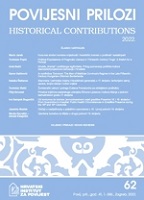Običaji u nasljeđivanju u pelješkim oporukama u 18. i prvoj polovini 19. stoljeća
Inheritance Customs in Last Wills from Pelješac Written during the 18th and the first half of the 19th Century
Author(s): Jasenka MaslekSubject(s): Cultural history, Ethnohistory, Cultural Anthropology / Ethnology, 18th Century, 19th Century
Published by: Hrvatski institut za povijest
Keywords: Pelješac peninsula; 18th century; inheritance; last wills; dowry; capital;
Summary/Abstract: The paper analyses last wills from the western, north-western, and central parts of the Pelješac peninsula in order to show the testators’ efforts to preserve the integrity of their estates and ensure the survival and prosperity of their families, with all the variety of customs used. Particular attention has been paid to the contribution made by each family member to maintain the property and the manner in which this was done. The form of inheritance depended on the trade of the testator or heir, i.e. whether they were seafarers, merchants, or tenant farmers. The form of the last wills and the provision of special conditions or trusts also depended on this, as well as the beginning of the separation of brothers and the dissolution of extended families or house cooperatives. As the bonds of cooperative life weakened while maritime and commercial activities gained on momentum, there was no longer any need for the son-in-law living with his wife’s family to take their name, as the house was no longer known by it. The improved financial situation of the family was the least beneficial for its female members, daughters, who continued to receive their dowry in inheritance or as severance pay.
Journal: Povijesni prilozi
- Issue Year: 2022
- Issue No: 62
- Page Range: 295-314
- Page Count: 21
- Language: Croatian

